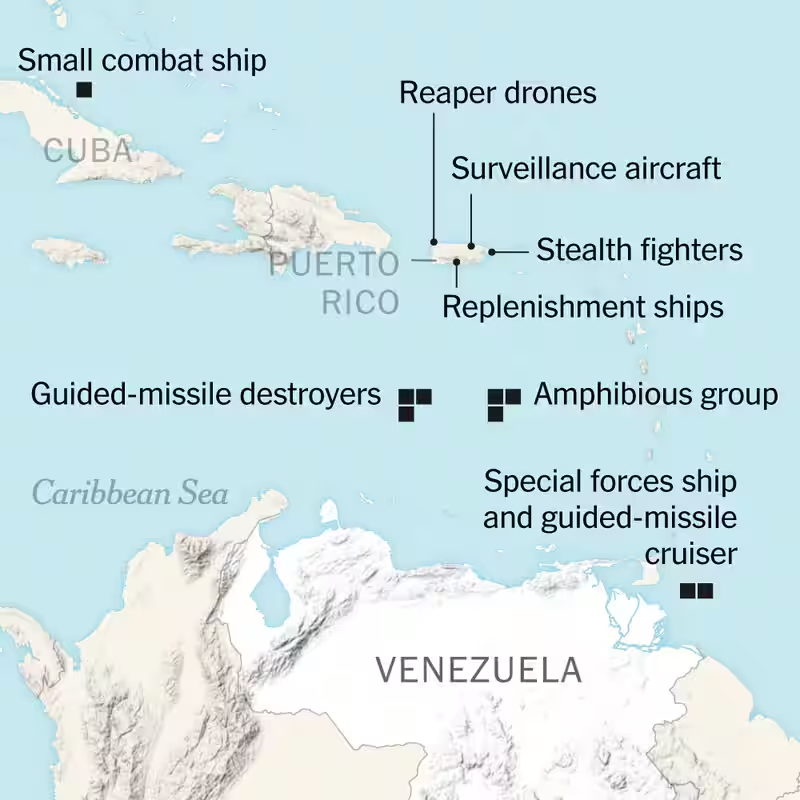Table of Contents
- The Scale of the U.S. Military Buildup
- Why Venezuela Is the Target
- Key U.S. Bases and Assets in the Region
- B-52s, Drones, and Covert Ops: A Calculated Show of Force
- What Comes Next for U.S.-Venezuela Relations?
- Sources
The Scale of the U.S. Military Buildup
In what experts are calling the largest U.S. military buildup in the Caribbean in decades, approximately 10,000 American troops—along with dozens of warships, fighter jets, drones, and support vessels—are now deployed across the region. The surge, which began in late August 2025, marks a dramatic escalation in the Trump administration’s posture toward Venezuela.
Roughly half of these forces are stationed aboard eight U.S. Navy warships, including 2,200 Marines equipped with F-35B fighter jets. The other half is based ashore—primarily in Puerto Rico—at repurposed civilian airports that now serve as forward operating hubs.
Why Venezuela Is the Target
While publicly framed as a “counterdrug and counterterrorism” mission, U.S. officials have privately confirmed the true objective: to pressure Venezuelan President Nicolás Maduro to step down.
President Trump has openly suggested the deployment could include covert CIA operations. In recent weeks, the U.S. has even conducted lethal strikes on vessels it claims were smuggling narcotics—posting videos of the attacks on social media as a warning to Maduro’s regime.
Key U.S. Bases and Assets in the Region
The U.S. military buildup in the Caribbean is centered on three strategic locations:
| Location | Assets Deployed | Strategic Role |
|---|---|---|
| Rafael Hernández Airport, Aguadilla (Puerto Rico) | MQ-9 Reaper drones, new ammunition bunker | Drone strike and surveillance hub |
| Roosevelt Roads Naval Station, Ceiba (Puerto Rico) | F-35 stealth fighters, AC-130 gunships, helicopters | Expeditionary air operations |
| St. Croix, U.S. Virgin Islands | KC-135 refueling tankers, new radar installation | Airspace monitoring and aerial refueling |
Satellite imagery and flight-tracking data confirm these deployments, with residents across the Caribbean posting photos and videos of low-flying military aircraft and naval vessels near Venezuela’s coast.
B-52s, Drones, and Covert Ops: A Calculated Show of Force
The buildup isn’t just about numbers—it’s about messaging. On October 16, two B-52 bombers from Louisiana flew for hours just off Venezuela’s coastline in international airspace. Though not a violation of sovereignty, the flight passed through an air traffic zone managed by Caracas—a deliberate provocation.
“It was a show of force,” a senior U.S. official told The New York Times. B-52s can carry dozens of precision-guided munitions, making them a potent symbol of U.S. strike capability.
Meanwhile, an elite Army Special Operations unit has been conducting helicopter drills between Venezuela and Trinidad and Tobago. Even more telling: satellite images captured the M.V. Ocean Trader—a vessel often used as a floating command center for covert missions—just 85 miles northeast of Venezuela.
What Comes Next for U.S.-Venezuela Relations?
While the Pentagon insists current operations are “training missions,” the scale and visibility of the U.S. military buildup in the Caribbean suggest otherwise. The Trump administration appears to be creating a menu of options—from intensified sanctions to potential kinetic action—should diplomatic pressure fail.
For now, Maduro remains defiant. But with U.S. assets circling ever closer, the Caribbean has become the frontline of a high-stakes geopolitical standoff that could reshape the Western Hemisphere.




